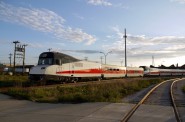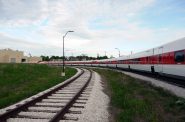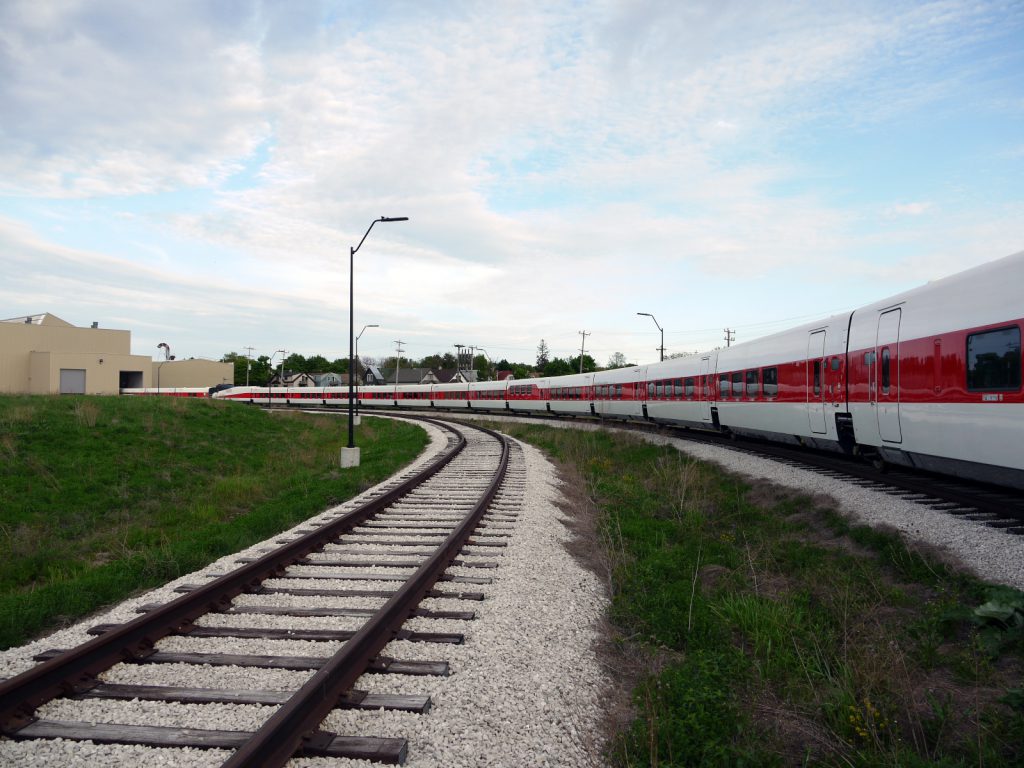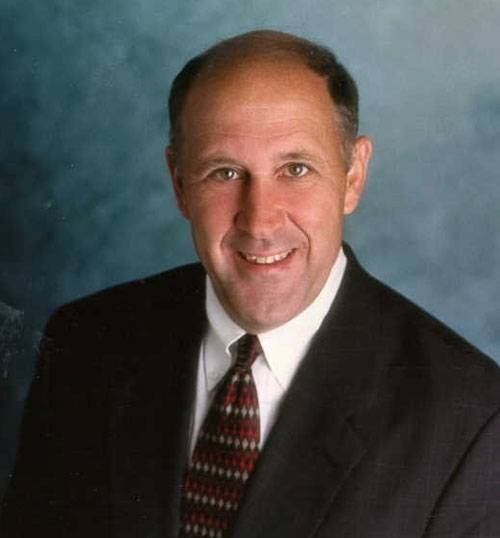Could Doyle Have Saved High Speed Rail?
And could the state still get it some day? Last in a series.
Should former Gov. Jim Doyle have moved ahead with the high-speed train when he was a lame duck?
Will Madison ever have passenger rail?
Also, what did the 2016 Olympics have to do with all of this?
Because the story of “Derailed” happened over the course of decades, there’s a lot there, and a lot we didn’t get to.
Some of it, like Doyle’s role in ending the train, is still discussed today. Other stuff, like the Olympics connection, seems to have been lost to history.
Here are some of the questions we didn’t get to in “Derailed.”
Did Gov. Jim Doyle Kill The Train?
There’s a key detail in the high-speed rail saga that sometimes gets overlooked: It wasn’t technically former Gov. Scott Walker who halted this project. It was former Gov. Jim Doyle.
Doyle paused work on the rail line two days after Walker was elected in 2010, and it never started back up again.
There are obvious reasons this is a footnote to the larger story of the train.
For one, Walker ran against this train in a very public way.
And key decision-makers point the finger at Walker. Ray LaHood, former President Barack Obama‘s Transportation Secretary, said, without a doubt, it was Walker who stopped the train. LaHood told WPR he tried to get Walker to change his mind after the election, but the governor-elect wouldn’t budge.
But other people who wanted this rail project vividly remember Doyle’s role in the decision. And some blame Doyle for not fighting harder.
On a Saturday morning at the Dane County Farmers’ Market in Madison in late September, Diane and Tim Osswald had a lot to say about Doyle.
“He understood where the incoming government stood on it, and he backed off,” said Diane Osswald. “And he shouldn’t have.”
“Doyle really needs to be blamed for it,” said Tim Osswald. “He was still the governor. So he basically, then, was handing in the keys to the house a few days before the lease was signed. You don’t do that.”
Walker was elected on Nov. 2, 2010, but Doyle was still governor, and he would still be running state government for another two months. Some Democrats thought he should have run it more aggressively.
Spencer Black, the Democratic state representative from Madison who put $50 million in rail bonding in the budget in 1993, was still a state representative in 2010. He wanted Doyle to move forward with the rail line, even after Walker’s election.
“Oh, I thought at the time — it’s not even hindsight — I mean right at the time I thought, you know, you should just get this done,” Black told WPR.
Doyle isn’t unaware of this sentiment, but he said he doesn’t feel like he ever had a choice.
“Does anybody really think I didn’t want this train?” Doyle told WPR. “I mean I, more than anybody in this whole story, I’m the one that brought this train here. I would have loved to have had this train.”
Doyle said the rail project was still in the early stages in November 2010 because the U.S. Department of Transportation wasn’t moving as quickly as he’d hoped. Even if he kept the project moving temporarily, he didn’t think it was fair to workers who would be laid off once Walker took office in January.
“There was no way in the world you could say to somebody, ‘Go to work on something that you’re going to have to quit working on in 30 days.’ So that’s the reality of where we were,” Doyle said.
Doyle was willing to take other political risks at the end of his governorship, pushing unsuccessfully to renew state employee contracts. Those contracts never passed the Democratic-controlled state Senate in 2010.
All of this is viewed in a different light today because of the way Walker used his last months in office as a lame-duck governor.
While Doyle chose not to go to the mat for the train in 2010, Walker was far more aggressive when he was a lame duck in 2018.
After Walker lost the 2018 election, Republican lawmakers moved quickly to pass laws that would limit the power of his Democratic successor, Tony Evers. And Walker supported it.
“The will of the voters four years ago was to elect me to a term that ends Jan. 7,” Walker said in December 2018. “And so I don’t stop. Even though the media treats an election as though that’s the end of the term, it’s not.”
Given the way Walker handled his last days in office, some Democrats think Doyle should have been more aggressive with the train.
Others think Doyle did the right thing. Dan Schoof, who was running Doyle’s state Department of Administration during his last months in office, said what Doyle did was honorable.
“Is Gov. Doyle not vindictive and partisan? No, he’s not,” Schoof said. “We’ll let history judge those eight years versus his eight years, you know? But I think yeah, this partisan jamming of things wasn’t his thing and ultimately probably isn’t good for the state.”
Did The 2016 Olympics Influence Wisconsin’s Train Debate?
Sometimes, when you’re working on a story like this, it takes you somewhere you didn’t expect to go.
For us, it’s the 2016 Summer Olympics.
That may sound completely out of the blue, but it’s an idea that stuck with us — one that we tried to chase all the way to the top.
The story starts with Chicago, which was one of four finalists for the 2016 Summer Games.
Chicago’s plan for the games included a cycling course in a neighboring state: Wisconsin. The course would be held in the rolling hills outside of Madison.
This was something Doyle would allude to from time to time when he was discussing the train, including at the 2009 press conference where he announced Wisconsin’s deal with Talgo.
He was using Chicago’s Olympic bid to promote a new passenger rail line to Madison, and it wasn’t just an aside. Doyle met with the International Olympic Committee in 2009, and spoke to reporters after the meeting.
“There was quite a bit of discussion I had with individual members of the (International Olympic Committee),” Doyle said. “And they were very interested in the potential of really high quality, high-speed passenger rail connecting Chicago with Madison.”
Part of the reason this stuck with us is that we were trying to figure out why the high speed rail funding in the 2009 federal stimulus bill grew by so much so fast.
When the stimulus bill first passed the U.S. House of Representatives, there was no money set aside for high-speed rail, and by the time it was signed into law, there was $8 billion.
A similar thing happened in Wisconsin. At first, the state was just looking to upgrade the Chicago to Milwaukee Hiawatha rail line. By the end it was asking for the full amount to extend the line to Madison. And it got it. Every single dime.
As we tracked the process of the stimulus bill, we realized all the rail funding got added at the last minute. And this is what really grabbed our attention.
Because who was involved in that last step of the process for the stimulus bill? The White House. Then-President Barack Obama.
So if he’s the one who really wanted this rail funding, we couldn’t help but wonder … why?
We had a theory. Obama is from Chicago. And he really wanted the 2016 Olympics to come to his hometown. What if his hometown needed that high-speed rail line to Madison to win its bid for the games?
We started looking for what he said about the Olympics, and we found a promotional video Obama made asking the Olympic Committee to consider Chicago.
“I deeply believe in the Olympic mission,” Obama said. “And have long supported hosting the Olympic and Paralympic Games in my home city of Chicago.”
What really got us about that video is when Obama made it: Nov. 21, 2008 — just a few weeks after he won the election. He wasn’t even president yet.
Less than a year later, while Obama was in the thick of the health care debate, he left the country with First Lady Michelle Obama. They went to Copenhagen to make a last-minute pitch for a Chicago games.
We were so curious about this, that we actually tried to get an interview with Obama, but we never heard back.
So we asked someone in his cabinet instead: Transportation Secretary LaHood.
We wanted to know: Did Obama pump money into rail to fund a train to Wisconsin to strengthen the Chicago Olympic bid?
LaHood’s answer was much simpler than our question.
“The Olympics coming to Chicago and the cycling portion of it for Wisconsin really played no role in the decision for funding this project,” LaHood said.
We asked other people, too. They also told us no, or that they didn’t remember.
Even still, we wanted to share this with you because it kind of consumed us for a while.
In the end, it probably doesn’t matter. Chicago didn’t get its Olympics, and Wisconsin didn’t get its train.
Did Tommy Thompson Want To Leave Amtrak?
Former Republican Gov. Tommy Thompson was a huge part of Wisconsin’s high-speed rail story, especially its beginning.
Thompson proposed the Madison to Milwaukee rail line in 1999, and he was putting the project in motion by early 2000. Those who knew him said that Thompson, through a combination of popularity and sheer force of will, usually got what he wanted.
And Thompson was in a position to make this happen. He was chairman of Amtrak and would use his trips to Washington, D.C., to speak up for Wisconsin’s rail project.
Then in early 2001, he left Wisconsin for a job as secretary of then-President George W. Bush‘s Health and Human Services (HHS). And without Thompson to push for the Madison to Milwaukee rail line, the project stalled for a decade.
When Thompson went to Washington, he gave up his Amtrak chairmanship. But it turns out, he didn’t want to.
“Oh, I did,” Thompson said. “I got in a fight with the … not with the president but with the chief of staff and the secretary of transportation.”
But Thompson’s new bosses in the Bush administration didn’t like this idea.
“They won out, and I got booted and as a result of that lost my power with Amtrak to keep pushing a Madison and Milwaukee rail service,” Thompson said. “So it was a big fight. A big controversy. All going on behind the scenes. I didn’t have much support in my own department for it. And I had none in the White House and none in the Department of Transportation. So I was bound to lose, but I stayed on longer than they ever thought before I finally had to step aside.”
This was one of many “what ifs” we ran into as we learned about this story. What if Thompson had been allowed to stay on Amtrak? Would he have pushed this train through?
Like the other what-ifs, we’ll never know.
What’s The Future Of Passenger Rail In Wisconsin?
One of the questions we get asked since we’ve been working on this podcast is whether the Madison to Milwaukee passenger rail line could ever happen. And this is a question we asked the people we interviewed, too.
Our best answer is: We can’t say. But what we do know is that grants like the $810 million Wisconsin got to build this rail line don’t come along often.
We also know this: There’s no regular passenger rail service to Madison. And some people, like former Madison Mayor Dave Cieslewicz, think there never will be.
“I do worry that we lost our chance,” Ciezlewicz said. “There’s also been talk from time to time about connecting Chicago to the Twin Cities through Illinois and Iowa and completely bypassing Wisconsin all together. That would be tragic.”
So is that possible? In a word: yes.
There is a push to bring back an Amtrak line linking Chicago to Dubuque, Iowa, through Rockford, Illinois. This is Amtrak’s old “Black Hawk” Line, which last ran in 1981.The railroad tracks run just to the edge of the Illinois state line without ever crossing into Wisconsin.
They pass through a small town called Apple River, Illinois, where Gerald Podraza lives. Podraza, who leads a citizens’ group that’s making a push to bring back the Black Hawk, imagines a train that not only connects his small town to the city but also encourages people who work in Chicago to live in rural Illinois.
“We know if we can attract people back from urban America, there’s going to be a positive change there,” Podraza said.
There are signs that this could actually happen.
The new Democratic governor in Illinois, J.B. Pritzker, signed a $45 billion dollar capital bill paid for in part by an expansion of gambling and an increase in the state’s gas tax. Included in the new law was $275 million for an Amtrak line from the Chicago suburbs to Rockford.
Charlie Wheeler has followed Illinois state government for 50 years, first as a reporter for the Chicago Sun Times and later as the director of the Public Affairs Reporting program at the University of Illinois at Springfield.
He said there’s a long history of passenger rail in Illinois, but it’s not as controversial as it is in Wisconsin.
“It’s certainly not that kind of an issue here,” Wheeler said. “It’s pretty well respected.”
With money in a capital budget and a rail corridor already in place, Wheeler said there’s a realistic chance the Black Hawk line could be revived. And some day, the line could connect Chicago to Minneapolis without ever passing through Wisconsin.
“I think it could be done,” Wheeler said. “Now, what it would cost and if you look at basic geometry, it’s a longer route. But it’s certainly not something out of the realm of possibility.”
There is already a passenger rail line that runs from Chicago to the Twin Cities through Wisconsin, the Amtrak Empire Builder. It stops in a handful of Wisconsin cities including Milwaukee, Tomah and La Crosse, with a final destination of Seattle.
The Empire Builder comes through once a day but it doesn’t stop in Madison. The closest it gets is Columbus, about a 40-minute drive away.
Some people are trying to add a second daily train on this line from Chicago to the Twin Cities, but as of now it hasn’t happened.
There’s another Amtrak line in Wisconsin — the Hiawatha between Chicago and Milwaukee where the Talgo trains were going to run. That line remains one of the busiest in the country.
As “Derailed” was being released, the Legislature’s budget committee authorized $13 million in state funding to purchase new Amtrak train cars for the Hiawatha line. And they won’t be made by Talgo.
Listen to the bonus episode of the podcast here.
Lame Duck, The Olympics And The Future Of High-Speed Rail was originally published by Wisconsin Public Radio.
This story is part of WPR’s “Derailed,” a limited-run podcast about Wisconsin’s high-speed rail line that never was. It’s a look at how the project came together, how it fell apart, and what it says about how Wisconsin has changed. Never miss an episode by subscribing now on your favorite podcast app or at wpr.org/derailed.
Derailed
-
Talgo Trains Return to Milwaukee
 Dec 10th, 2019 by Bridgit Bowden and Shawn Johnson
Dec 10th, 2019 by Bridgit Bowden and Shawn Johnson
-
How Republicans Became Anti-Train
 Nov 15th, 2019 by Bridgit Bowden and Shawn Johnson
Nov 15th, 2019 by Bridgit Bowden and Shawn Johnson
-
How Waterloo Lost High Speed Rail
 Nov 13th, 2019 by Hannah Haynes
Nov 13th, 2019 by Hannah Haynes
Transportation
-
MCTS Adds 28 New Buses
 Jul 13th, 2024 by Graham Kilmer
Jul 13th, 2024 by Graham Kilmer
-
MCTS Designing New Bus Shelters
 Jul 10th, 2024 by Graham Kilmer
Jul 10th, 2024 by Graham Kilmer
-
MCTS Updates RNC Bus Detours To Better Serve Downtown, Riders
 Jul 9th, 2024 by Jeramey Jannene
Jul 9th, 2024 by Jeramey Jannene





















